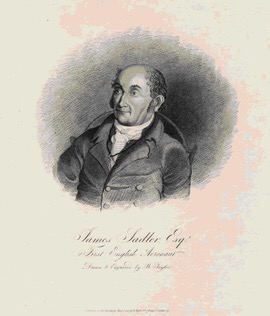Manchester’s newest public square is to be named in honour of a man who made the first balloon flight in Manchester, but who was James Sadler and why did this Oxfordshire come to Manchester?
It’s May 1785, George III is on the throne, France still has a king and in the town of Manchester from the garden of john Howarth in Long Millgate, a strange device that generates hydrogen gas in casks containing small pieces of iron with diluted sulphuric acid is switched on, inflating a balloon.
The man at the controls is a thirty two year old, the eldest son of a pastry chef and confectioner, born in Oxford who the previous year had been the first man in Britain to fly.
This was second attempt of the year, and with a crowd of five thousand gathering to witness this scientific marvel, he took off, it is said with a cat for company and flew seven miles north to Radcliffe taking an hour and three quarters before landing in a reed bed.
Sadler is strangely forgotten by many today, yet over two hundred and fifty years ago he was a celebrity, followed by thousands in his quest for flight.In the towns where he appeared, they would even take a holiday to watch him.
Only two years earlier in 1783 had man conquered flight fir the first time, Joseph and Etienne Mongolfier taking off from the centre of Paris in the flight that lasted twenty minutes. Inspired by the brothers, Sadler began to experiment with gas filled balloons and in 1784 in a crude balloon he had made himself, took off from Oxford, rising three quarters of a mile and flying for half an hour for six miles.
This is how the Oxford Journal reported his flight
Oxford Journal, October 4, 1784
Early on Monday Morning the 4th instant, Mr. Sadler of this City, tried the Experiment of his Fire Balloon, raised by means of rarefied air. The Process of filling the Globe began at three o’clock, and about Half past Five as all was complete, and every Part of the Apparatus entirely adjusted, Mr. Sadler, with Firmness and Intrepidity, ascended into the Atmosphere, and the Weather being calm and serene, he rose from the Earth in a vertical direction to a Height of 3,600 Feet. In his elevated Situation he perceived no Inconvenience; and, being disengaged from all terrestrial Things, he contemplated a most charming distant View. After floating for near Half an Hour, the machine descended, and at length came down upon a small Eminence betwixt Islip and Wood Eaton, about six Miles from this City.
A second flight a month later would be more robust, the balloon this time powered by hydrogen, giving it greater capacity and endurance.
He travelled for twenty miles but had not mastered the art of landing, for his balloon was dragged into a tree and destroyed, Sadler escaping uninjured.
The following year he made four ascents, two in Manchester, the second saw him fly as far as Pontefract but once again when landing the balloon dragged him across the ground.Later that year at Lichfield, he narrowly avoided serious injury when he fell from the balloon on landing losing his equipment, propelled into the air never to be seen again.
In all he made forty seven ascents, the last in 1815, and retired to die peacefully in his bed in 1828, the first Englishmen ever to fly and Manchester played a small part in his story.







